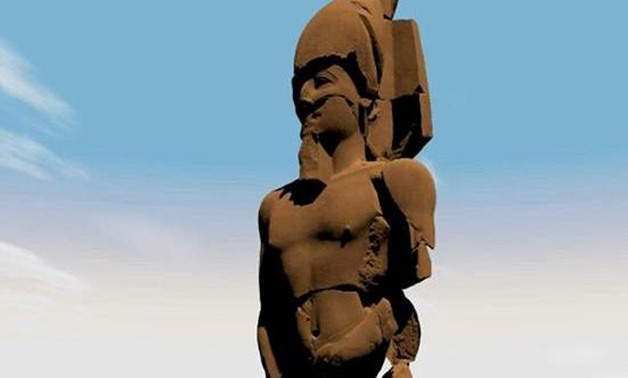
King Psamtek I's colossus of Matariya re-imagined - Courtesy of Ministry of Antiquities
CAIRO – 11 April 2018: The Egyptian-German Mission at Matariya/Heliopolis discovered an assortment of 4500 fragments from King Psamtek I's colossus on Wednesday April 11, according to an official statement by Ministry of Antiquities.
 New discovery of 4500 fragments from King Psamtek I's colossus in Matariya, -Photo by Ministry of Antiquities.
New discovery of 4500 fragments from King Psamtek I's colossus in Matariya, -Photo by Ministry of Antiquities.
Some fragments of the colossus have been discovered in 2017 and were placed in the Egyptian Museum in Tahrir.
 One of the mission's member repairs the newly discovered fragments in Mtariya, -Photo by Ministry of Antiquities.
One of the mission's member repairs the newly discovered fragments in Mtariya, -Photo by Ministry of Antiquities.
Ayman Ashmawy, head of the Ancient Egyptian Antiquities Department at the Ministry of Antiquities and head of the Egyptian mission, mentioned in the statement that the mission has successfully managed to discover a collection of 4500 fragments of the quartzite colossus of king Psamtek I at Souq el-Khamis area in Matariya.
 One of the monuments found in the site of the new discoveries, -Photo by Ministry of Antiquities.
One of the monuments found in the site of the new discoveries, -Photo by Ministry of Antiquities.
He added that by gathering the fragments discovered in 2017 and 2018, they collected 6400 fragments, giving a better picture of the colossus of king Psamtek I before its devastation in the old times.
 Imaginary graphic for the newly discovered fragments in Matariya, -Photo by Ministry of Antiquities.
Imaginary graphic for the newly discovered fragments in Matariya, -Photo by Ministry of Antiquities.
Ashmawy also clarified that the new fragments helped to confirm that the colossus depicts a standing king, with his left arm in front of the body while the right one is extended to the back.
 Accurate crafts on one of the the newly discovered fragments in Matariya, -Photo by Ministry of Antiquities.
Accurate crafts on one of the the newly discovered fragments in Matariya, -Photo by Ministry of Antiquities.
An accurately carved piece on the back-pillar shows king Psamtek I kneeling to creator-god Aton of Heliopolis.
 Imaginary graphic for a part of the statue of King Psamtek I, -Photo by Ministry of Antiquities.
Imaginary graphic for a part of the statue of King Psamtek I, -Photo by Ministry of Antiquities.
The vast majority of the fragments were found in a pit south of the pedestal of the statue that has been left open probably since the Fatimid era. Ashmawy stated that the fragments of the recent discovery will be sent to the Egyptian Museum.
Dietrich Raue, head of the German mission said that the discovery includes a large number of fragments that belong to a quartzite gate of Ramses II (1279-1213) and Nektanebo I.
 A view for the archeological site of the new discovery in Matariya, -Photo by Ministry of Antiquities.
A view for the archeological site of the new discovery in Matariya, -Photo by Ministry of Antiquities.
He pointed out that there are some exceptional pieces among the fragments; such as: a frieze of falcons, a part of a gate of Merenptah (1213-1201 BC), as well as parts of a Ramesside colossal sphinx of red granite.
 An archaeological works on repairing one of the newly discovered fragments in Matariya , -Photo by Ministry of Antiquities.
An archaeological works on repairing one of the newly discovered fragments in Matariya , -Photo by Ministry of Antiquities.
The excavation work in the Ptolemaic workshop area also led to the discovery of new room units of the mid-Ptolemaic era. The work was done with the support of archaeobotanical and archaeozoological studies.
 A big fragments from the new discovery in Matariya, -Photo by Ministry of Antiquities.
A big fragments from the new discovery in Matariya, -Photo by Ministry of Antiquities.
 One of the fragments discovered in Mtariya last year, -Photo by Ministry of Antiquities
One of the fragments discovered in Mtariya last year, -Photo by Ministry of Antiquities










Comments
Leave a Comment